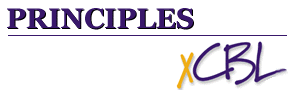
 |
|
|

xCBL 2.0 was designed to model the information requirements for business-to-business electronic commerce transactions, to encourage adoption and interoperability by building on existing EDI standards, to enable modular composition of XML documents from reusable building blocks, and to support a variety of programming models. Enabling the Exchange of Business Information A first step to modeling information requirements of business-to-business electronic commerce is the identification of a small set of core documents that could be used to conduct the majority of business transactions. xCBL 2.0 provides schemas to represent the following business documents:
Each of these documents is constructed from a set of modules or XML building blocks that represent name, address, price, unit of measure, and other dimensions. xCBL's extensible architecture allows trading partners to modify the business documents, adding elements as needed. The documents can support the business needs of both ad hoc trading communities and long-term enterprise trading relationships. An Example of the Design Process The following example illustrates how the design principles were applied when modeling the product and pricing catalogs. The EDIFACT standard defines two documents related to listing of parts, the Product Catalog and the Price Catalog. The Product Catalog provides detailed information about the parts in a supplier's catalog including descriptions, parametric data, and packaging information. The Price Catalog provides pricing information and optional descriptive information for those parts. Pricing in the Pricing Catalog is quite flexible and rich, enabling it to support multiple currencies, tiered pricing, and allowances and charges based on quantities purchased. EANCOM defines standard subsets of the EDIFACT UNSMs for these documents. SIMPL-EDI defines these in a format that is a subset of the EANCOM documents. xCBL defines SOX schemas ProductCatalog.sox (which corresponds to the Product Catalog), and PriceCatalog.sox (which corresponds to the Pricing Catalog). The xCBL documents are based on the SIMPL-EDI versions with some extensions taken from EANCOM. For example, SIMPL-EDI assumes that product descriptions in free text form are not needed in the Product Catalog and allows only for descriptions using code numbers that can be looked up elsewhere. EANCOM does permit free text descriptions and the EANCOM extensions for this capability were used in the xCBL documents. The xCBL catalog documents follow the conventions used in other xCBL documents. For example, where a list of standard choices exists, the documents allow for picking from that list, or for specifying a value that is not on that list. The catalog documents are also built around the elements, such as Agency, Money, Party, and PartNum, common to all CBL documents.
|
||||
|
||||